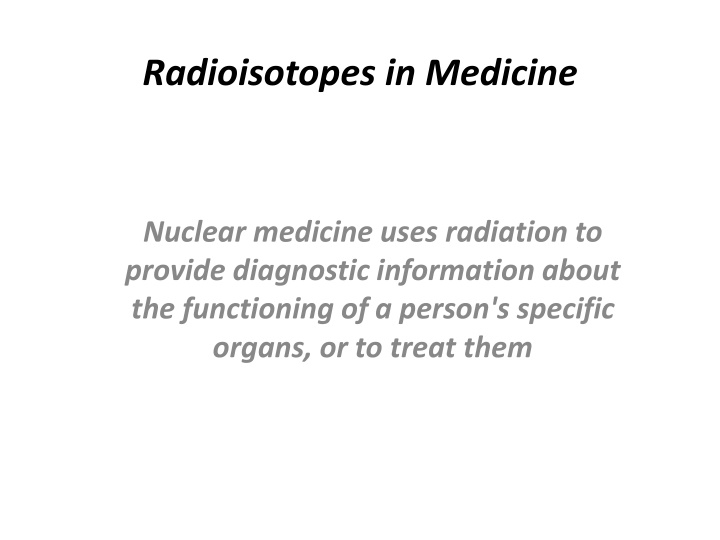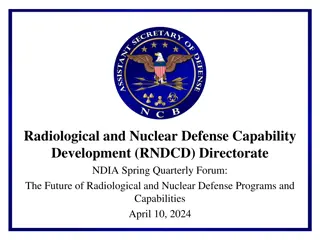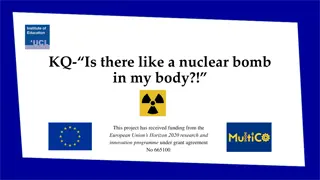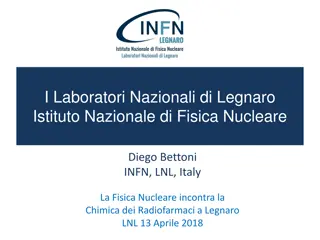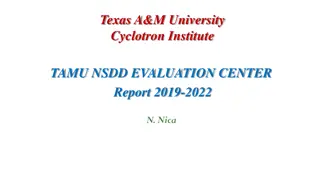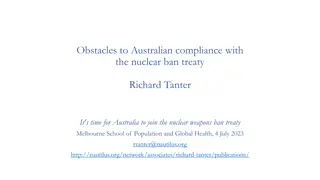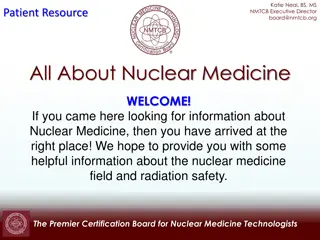Applications of Radioisotopes in Nuclear Medicine
Nuclear medicine utilizes radioisotopes to provide crucial diagnostic information about the functioning of specific organs and to treat various conditions. Diagnostic techniques in nuclear medicine involve using radioactive tracers that emit gamma rays from within the body. Positron Emission Tomography (PET) plays a significant role in oncology by utilizing fluorine-18 as a tracer, offering non-invasive cancer detection. PETCT combines PET with CT scans for improved diagnostic accuracy. Nuclear imaging provides advantages over traditional x-ray techniques, offering successful imaging of both bone and soft tissue. Diagnostic radiopharmaceuticals are instrumental in assessing various organ functions and predicting surgical outcomes. The non-invasive nature of nuclear imaging makes it a powerful diagnostic tool.
Uploaded on Sep 06, 2024 | 0 Views
Download Presentation

Please find below an Image/Link to download the presentation.
The content on the website is provided AS IS for your information and personal use only. It may not be sold, licensed, or shared on other websites without obtaining consent from the author.If you encounter any issues during the download, it is possible that the publisher has removed the file from their server.
You are allowed to download the files provided on this website for personal or commercial use, subject to the condition that they are used lawfully. All files are the property of their respective owners.
The content on the website is provided AS IS for your information and personal use only. It may not be sold, licensed, or shared on other websites without obtaining consent from the author.
E N D
Presentation Transcript
Radioisotopes in Medicine Nuclear medicine uses radiation to provide diagnostic information about the functioning of a person's specific organs, or to treat them
Diagnostic techniques in nuclear medicine Use of radioactive tracers which emit gamma rays from within the body. The tracers can be given by injection, inhalation or orally. The first type is where single photons are detected by a gamma camera which can view organs from many different angles (SPECT)
Positron Emission Tomography (PET) It is most important clinical role in oncology, with fluorine-18 as the tracer, since it has proven to be the most accurate non-invasive method of detecting and evaluating most cancers. It is also well used in cardiac and brain imaging.
PETCT New procedures combine PET with computed X-ray tomography (CT) scans to give co- registration of the two images (PETCT), enabling 30% better diagnosis than with traditional gamma camera alone. It provides unique information on a wide variety of diseases from dementia to cardiovascular disease and cancer (oncology)
A distinct advantage of nuclear imaging over x-ray techniques is that both bone and soft tissue can be imaged very successfully. The mean effective dose is 4.6 mSv per diagnostic procedure.
Diagnostic Radiopharmaceuticals Diagnostic radiopharmaceuticals can be used to examine blood flow to the brain, functioning of the liver, lungs, heart or kidneys, to assess bone growth, and to confirm other diagnostic procedures. Another important use is to predict the effects of surgery and assess changes since treatment.
The non-invasive nature of this technology, together with the ability to observe an organ functioning from outside the body, makes this technique a powerful diagnostic tool.
technetium-99m The radioisotope most widely used in medicine is technetium-99m. It is an isotope of the artificially-produced element technetium and it has almost ideal characteristics for a nuclear medicine scan. These are: It has a half-life of six hours which is long enough to examine metabolic processes yet short enough to minimise the radiation dose to the patient.
Technetium-99m decays by a process called "isomeric"; which emits gamma rays(140kev). The low energy gamma rays it emits easily escape the human body and are accurately detected by a gamma camera. The chemistry of technetium is so versatile, it can form tracers by being incorporated into a range of biologically-active substances.
Other Diagnostic RN Myocardial Perfusion Imaging (MPI) uses thallium-201 chloride or technetium-99m and is important for detection and prognosis of coronary artery disease. Fluoro-deoxy glucose (FDG) incorporating F-18 - with a half-life of just under two hours, as a tracer. The FDG is readily incorporated into the cell without being broken down, and is a good indicator of cell metabolism
Therapeutic Radiopharmaceuticals For some medical conditions, it is useful to destroy or weaken malfunctioning cells using radiation. In most cases, it is beta radiation which causes the destruction of the damaged cells. This is radionuclide therapy (RNT) or radiotherapy
Radionuclide therapy (RNT) Rapidly dividing cells are particularly sensitive to damage by radiation. For this reason, some cancerous growths can be controlled or eliminated by irradiating the area containing the growth. External irradiation (sometimes called teletherapy) can be carried out using a gamma beam from a radioactive cobalt-60 source.
Brachytherapy Internal radionuclide therapy is by administering or planting a small radiation source. Short-range radiotherapy is known as brachytherapy, and this is becoming the main means of treatment. Iodine-131 is commonly used to treat thyroid cancer.
. Iridium-192 implants are used especially in the head and breast. This brachytherapy (short-range) procedure gives less overall radiation to the body, is more localized to the target tumor and is cost effective
Systemic RN An ideal therapeutic radioisotope is a strong beta emitter with just enough gamma to enable imaging, e.g. lutetium-177. This is prepared from ytterbium-176 which is irradiated to become Yb-177 which decays rapidly to Lu-177.
Yttrium-90 is used for treatment of cancer, particularly non-Hodgkin's lymphoma, liver tumors and its more widespread use is envisaged, including for arthritis treatment. Lu-177 and Y-90 are becoming the main RNT agents.
Iodine-131 is used to treat the thyroid for cancers and other abnormal conditions such as hyperthyroidism (over-active thyroid). In a disease called Polycythemia vera, an excess of red blood cells is produced in the bone marrow. Phosphorus-32 is used to control this excess.
Targeted Alpha Therapy (TAT) New field of therapy is targeted alpha therapy ( Boron Neutron capture therapy) : Used especially for the control of dispersed cancers. The short range of very energetic alpha emissions in tissue means that a large fraction of that radioactive energy goes into targeted cancer cells , once the patient has taken up alpha- emitting radionuclide to exactly the right place.
Administration boron10 to the patient , will concentrates in the malignant brain tumors. The patient is then irradiated with thermal neutrons which are strongly absorbed by the boron, producing high energy alpha- particles which will kill the cancer (B10 + n Li+ .. ) This requires the patient to be come to a nuclear reactor, rather than radioisotopes being taken to the patient .
